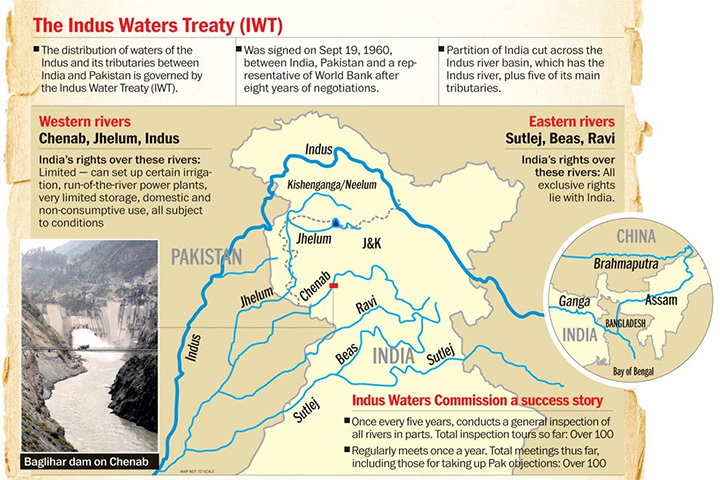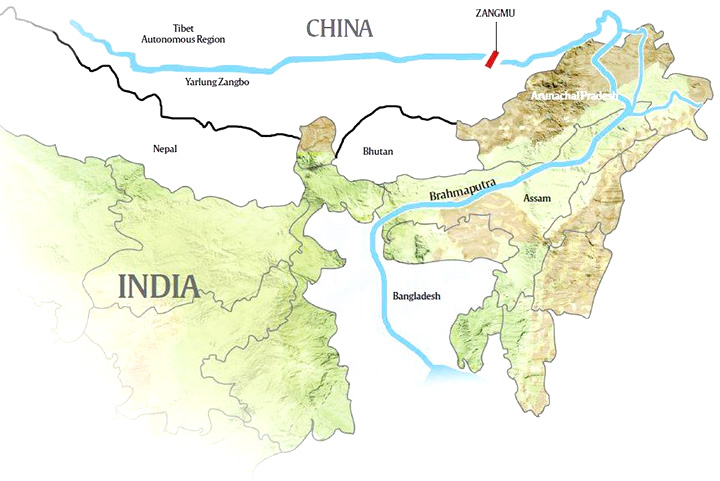Governance
Report on Water Resource Management
- 06 Aug 2021
- 7 min read
Why in News
Recently, a report was tabled in Rajya Sabha by the Standing Committee on Water Resources.
- The report is titled “Flood Management in the Country including International Water Treaties in the field of Water Resource Management with particular reference to Treaty/Agreement entered into with China, Pakistan and Bhutan”.
- The Government of India should renegotiate the Indus Water Treaty of 1960 with Pakistan in the light of present-day challenges such as climate change and constantly monitor ‘Chinese actions’ over Brahmaputra.
Key Points
- On Flood Management:
- The committee recommended setting up of a permanent institutional structure in the form of National Integrated Flood Management Group under the chairmanship of the Minister of Jal Shakti “immediately” for control and management of floods in the country.
- This group should take up the overall responsibility of coordination as well as building synergies between all agencies responsible for management of floods and their consequences on life and property.
- On Indus Water Treaty:
- Highlighted Impacts of Climate Change:
- Rainfall Pattern: There are instances of more high-intensity rainfall as well as long stretches where there is low rainfall.
- Glacial Melt: The contribution of glaciers in the Indus basin is higher than in the Ganges or Brahmaputra basins.
- Disasters: Because there is a fragile Himalayan region involved, there is greater frequency of landslides and flash floods.
- Utilisation of the Waters of the Indus:
- India was able to make full use of the ‘Eastern Rivers’, namely the Ravi, Beas and Satluj through a series of dams such as Ranjit Sagar on the Ravi in Pathankot, Pong on the Beas and Bhakra Nangal on the Satluj.
- However, canals in Punjab and Rajasthan such as the Rajasthan Feeder and the Sirhind Feeder had become old and were not maintained properly. This had resulted in the lowering of their water carrying capacity.
- Thus, the water from the Harike Barrage on the confluence of the Beas and Satluj in Punjab was usually released downstream into Pakistan.
- It urged the Centre to expedite new projects like the one on the Ujh, a tributary of the Ravi, as well as the Shahpurkandi on the Ravi itself to exploit the full potential of the rivers for irrigation and other purposes.
- It also recommended that the canal systems in Punjab and Rajasthan be repaired to increase their water carrying capacity.
- Renegotiation of Indus Water Treaty:
- Present day pressing issues such as climate change, global warming and environmental impact assessment etc. were not taken into account by the Treaty signed in 1960.
- There is a need to re-negotiate the Treaty so as to establish some kind of institutional structure or legislative framework to address the impact of climate change on water availability in the Indus basin and other challenges which are not covered under the Treaty.
- Highlighted Impacts of Climate Change:
- On China’s Development on Brahmaputra:
- Committee expressed apprehension that though ‘run of the river’ projects undertaken by China per se may not lead to diversion of waters, but there is every possibility that water can be stored in pondages and released for running the turbines.
- This may lead to certain diurnal variation in downstream flow and as a consequence have an impact on water flows in Brahmaputra river and thus affect India’s endeavours to tap the region’s water resources.
- Three hydropower projects on the main stream of Brahmaputra River in Tibet Autonomous Region have been approved by the Chinese authorities and a hydropower project at Zangmu was declared fully operational by Chinese authorities in October 2015.
- India should constantly monitor the Chinese actions so as to ensure that they do not pursue any major interventions on Brahmaputra river which would adversely affect our national interests.
- The committee expressed satisfaction at the fact that China is sharing hydrological data with regard to the Brahmaputra and Sutlej, though on payment basis.
- There is no water treaty between India and China at present.
- Committee expressed apprehension that though ‘run of the river’ projects undertaken by China per se may not lead to diversion of waters, but there is every possibility that water can be stored in pondages and released for running the turbines.
- Cooperation with Bhutan:
- A scheme titled “Comprehensive Scheme for Establishment of Hydro-meteorological and Flood Forecasting Network on rivers Common to India and Bhutan” is in operation.
- Rivers common to India and Bhutan include Manas river, Sankosh river, etc.
- The network consists of 32 Hydro-meteorological/meteorological stations located in Bhutan and being maintained by the Royal Government of Bhutan with funding from India. The data received from these stations are utilized in India for formulating flood forecasts.
- A Joint Group of Expert (JGE) on Flood Management has been constituted between India and Bhutan to discuss and assess the probable causes and effects of the recurring floods and erosion in the southern foothills of Bhutan and adjoining plains in India and recommend to both Governments appropriate and mutually acceptable remedial measures.
- A scheme titled “Comprehensive Scheme for Establishment of Hydro-meteorological and Flood Forecasting Network on rivers Common to India and Bhutan” is in operation.








